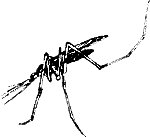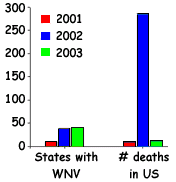| West Nile Virus, Update 2003 |
| West Nile Virus, Update 2003 |
|
By Ellen Kuwana Neuroscience for Kids Staff Writer August 22, 2003 Brace yourself, or should I say "Spray yourself!" Late August through September is the peak time for West Nile infections, a virus that is spread by mosquitoes. West Nile Virus (WNV) has been with us in the Western Hemisphere for four years. Scientists have made progress towards identifying and treating WNV cases in animals ranging from birds to horses to humans. Progress has also been made in developing a vaccine for WNV, although that weapon in the fight against WNV is still a few years away from being fully tested and available to humans. |
 Image courtesy of the USDA Agricultural Research Service |
 | Birds are a "Sentinel" SpeciesIn 1999, a large die-off of American crows alerted scientists to the presence of WNV. In response, public health officials mobilized to educate the public about WNV and the mosquitoes' role in its transmission. Since 1999, more than 130 species of birds have been identified as being infected with WNV. Like humans, not all of the infected birds die. A dead bird, however, may be a sign that WNV is in the area. Thus, birds are referred to as a "sentinel" species, as they generally get infected before humans, and serve as an alarm system for the presence of WNV. The Centers for Disease Control and Prevention (CDC) have instructions on how to report a dead bird to state or federal agencies, and how to dispose of the carcass safely. |
Testing and Vaccine DevelopmentMost people who are bitten by a mosquito do not come down with WNV, so there is no need to run to the doctor for testing, although a WNV test has been available since July of 2003. There is a hybrid vaccine in development that has been shown to protect horses and primates. If all goes smoothly in the testing of the vaccine, in a few years a vaccine for WNV will be available for humans.How 2003 Compares to Past Years: Record Number of Cases for 2003Last year had been the worst year on record in the United States for WNV, with were 4156 cases and 284 deaths. As of September 24, 2003, with 4156 cases and 284 deaths. As of September 24, 2003, 4827 cases had been confirmed by the CDC. The bright spot in this news is that it appears that fewer people died this year of WNV: 93 deaths this year so far, compared with 284 deaths last year. While most of the people infected with WNV exhibited mild, flu-like symptoms, approximately 30% had more severe central nervous system affects, such as meningitis, encephalitis, paralysis, or coma. In the meantime, until cooler weather and shorter day herald an end to mosquito season, it is important to continue to take precautions such as reducing the mosquito population, wearing protective clothing, and using an insect repellant such as DEET. |
 Statistics from the CDC. Note: statistics for 2003 are for January 1 - August 22 only. |
Hear It!
| DEET | Encephalitis |
| FAST FACTS
|
|
|
References and further information:
|
| GO TO: | Neuroscience In The News | Explore the Nervous System | Table of Contents |
![[email]](./gif/menue.gif) Send E-mail |
 Fill out survey |
 Get Newsletter |
 Search Pages |
 Take Notes |